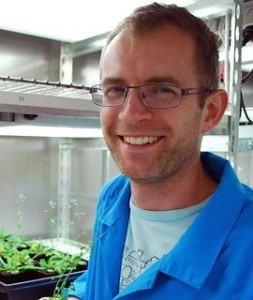 Mark Waters hails from the southern regions of the UK. He went to school in Bedford and was fortunate to study Biological Sciences at the University of Oxford. Here he nurtured his curiosity towards understanding plant growth and development after becoming inspired by a first year practical class on photosynthesis. After completing his PhD at the University of Nottingham studying plastid stromules with Kevin Pyke, he returned to the Department of Plant Sciences at Oxford for a post-doc stint with Jane Langdale. There he investigated the transcriptional regulation of chloroplast development, picking up essential skills in genetics and molecular biology. Next Mark moved to Australia in 2010 having been attracted to the impressive reputation of the ARC Centre of Excellence in Plant Energy Biology at the University of Western Australia (UWA). He joined Steve Smith’s group to explore the nascent field of karrikin signalling in plants.
Mark Waters hails from the southern regions of the UK. He went to school in Bedford and was fortunate to study Biological Sciences at the University of Oxford. Here he nurtured his curiosity towards understanding plant growth and development after becoming inspired by a first year practical class on photosynthesis. After completing his PhD at the University of Nottingham studying plastid stromules with Kevin Pyke, he returned to the Department of Plant Sciences at Oxford for a post-doc stint with Jane Langdale. There he investigated the transcriptional regulation of chloroplast development, picking up essential skills in genetics and molecular biology. Next Mark moved to Australia in 2010 having been attracted to the impressive reputation of the ARC Centre of Excellence in Plant Energy Biology at the University of Western Australia (UWA). He joined Steve Smith’s group to explore the nascent field of karrikin signalling in plants.
Named after the local Noongar word for smoke, karrikins are small molecules produced by burning vegetation, and are thus prevalent in the post-bushfire environment characteristic of Australia. The seeds of many plant species germinate upon exposure to plant-derived smoke, and Gavin Flematti at UWA identified karrikins as one of the bioactive compounds in 2004. The karrikin story therefore has a decidedly Australian flavour.
Genetic screens for karrikin-insensitive mutants of Arabidopsis thaliana led to the major discovery that formed the basis for Mark’s 2015 Goldacre Award: the identification and characterisation of the karrikin receptor protein KAI2. This work, published in Development in 2012, provided strong evidence that all plants, not just those adapted to fire-prone environments, possess the key machinery for detecting karrikins.
KAI2 belongs to a family of hydrolase-type proteins that also incudes DWARF14, the receptor for the strigolactone class of plant hormones. Strigolactones influence several developmental processes, most notably shoot branching. Karrikins and strigolactones are chemically similar, as both compounds possess the same “butenolide” structure that is essential for bioactivity. Mark’s research has demonstrated that KAI2 and DWARF14 are structurally similar proteins with quite different physiological functions. As a result, his work has positioned karrikins as abiotic plant growth regulators that are distinct from strigolactones, each having a respective receptor protein with different ligand specificities (Waters et al. 2012, Scaffidi et al. 2013, Scaffidi et al. 2014).
Some of Mark’s more recent work has described the evolutionary conservation of KAI2-dependent signalling in plants. KAI2-type proteins can be traced back to the algal ancestors of land plants, and crucially they are functionally conserved between lycophyte ferns and angiosperms, which diverged over 400 million years ago (Waters et al., 2015). This finding implies that KAI2 is fundamentally important to plant development, a fact borne out by the dramatic seed germination, seedling growth and leaf development phenotypes of KAI2-deficient mutants. In light of the fact that most plants do not encounter karrikins under natural conditions, it is possible that KAI2 has evolved not to perceive smoke, but instead to detect related butenolide compounds that remain to be discovered.
Dr Waters will explore the interface between chemical genetics and molecular biology and hopes to identify new butenolide compounds. He aims to dissect plant hormone interaction networks involved in plant development and perhaps exploit the KAI2 signalling system for crop improvement strategies. Mark and his colleagues have instigated a smoking hot area of research discovery into such an amazing chemical rich in Australian ecological significance.
Contact:
Email: mark.waters”at”uwa.edu.au
URL: http://www.uwa.edu.au/people/mark.waters
Twitter: watersmt
Selected references
- 1. Waters, MT*, Nelson, DC, Scaffidi, A, Flematti, GR, Sun, YK, Dixon, KW, & Smith, SM (2012). Specialisation within the DWARF14 protein family confers distinct responses to karrikins and strigolactones in Arabidopsis. Development, 139, 1285–1295. http://doi.org/10.1242/dev.074567 (*corresponding author)
- 2. Scaffidi, A*, Waters, MT*, Ghisalberti, EL, Dixon, KW, Flematti, GR, & Smith, SM (2013). Carlactone-independent seedling morphogenesis in Arabidopsis. The Plant Journal, 76, 1–9. http://doi.org/10.1111/tpj.12265 (*Joint first authors)
- 3. Scaffidi, A, Waters, MT, Sun, YK, Skelton, BW, Dixon, KW, Ghisalberti, EL, et al. (2014). Strigolactone hormones and their stereoisomers signal through two related receptor proteins to induce different physiological responses in Arabidopsis. Plant Physiology, 165, 1221–1232. http://doi.org/10.1104/pp.114.240036
- 4. Waters, MT*, Scaffidi, A, Moulin, SLY, Sun, YK, Flematti, GR. & Smith, SM (2015). A Selaginella moellendorffii ortholog of KARRIKIN INSENSITIVE2 functions in Arabidopsis development but cannot mediate responses to karrikins or strigolactones. Plant Cell, 27, 1925–1944. http://doi.org/10.1105/tpc.15.00146
(*corresponding author)
